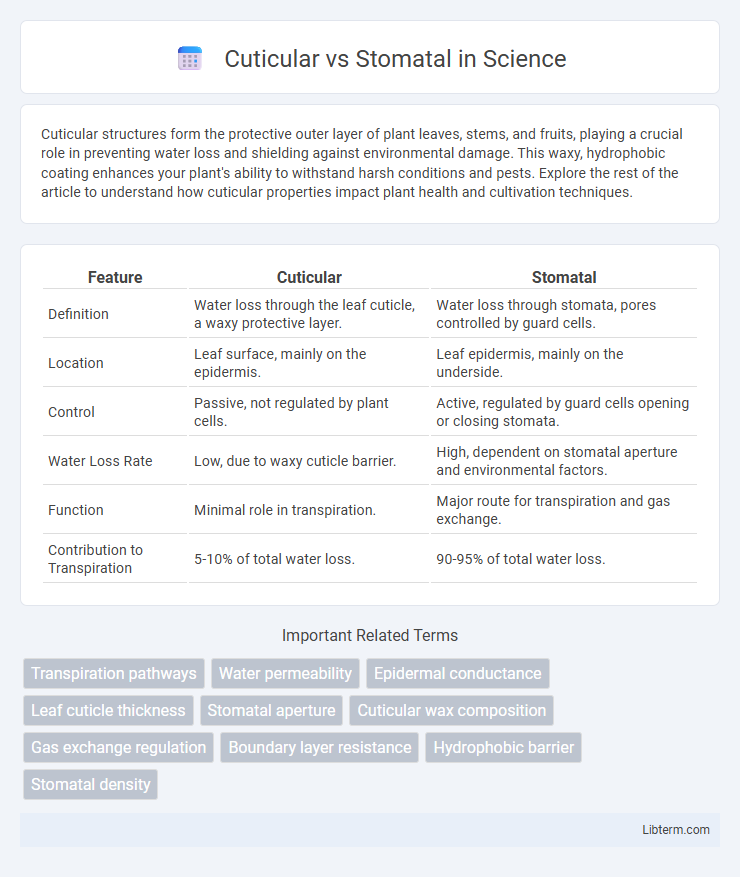Cuticular structures form the protective outer layer of plant leaves, stems, and fruits, playing a crucial role in preventing water loss and shielding against environmental damage. This waxy, hydrophobic coating enhances your plant's ability to withstand harsh conditions and pests. Explore the rest of the article to understand how cuticular properties impact plant health and cultivation techniques.
Table of Comparison
| Feature | Cuticular | Stomatal |
|---|---|---|
| Definition | Water loss through the leaf cuticle, a waxy protective layer. | Water loss through stomata, pores controlled by guard cells. |
| Location | Leaf surface, mainly on the epidermis. | Leaf epidermis, mainly on the underside. |
| Control | Passive, not regulated by plant cells. | Active, regulated by guard cells opening or closing stomata. |
| Water Loss Rate | Low, due to waxy cuticle barrier. | High, dependent on stomatal aperture and environmental factors. |
| Function | Minimal role in transpiration. | Major route for transpiration and gas exchange. |
| Contribution to Transpiration | 5-10% of total water loss. | 90-95% of total water loss. |
Introduction to Leaf Permeability
Leaf permeability is primarily governed by two key pathways: the cuticular and stomatal routes, each influencing gas exchange and water loss in plants. The cuticular pathway involves the waxy cuticle layer that covers the leaf surface, providing a barrier to water diffusion while allowing limited gas permeability. Stomatal permeability is controlled by microscopic pores called stomata, which regulate gas exchange by opening and closing in response to environmental and physiological signals.
Understanding Cuticular Pathways
Cuticular pathways refer to the movement of gases and water vapor through the cuticle, a waxy, protective layer on the plant surface that limits water loss and gas exchange. Unlike stomatal pathways that regulate gas exchange through pores, cuticular pathways involve passive diffusion across the cuticle's lipid and polymer matrix, influencing plant transpiration and water use efficiency. Understanding cuticular conductance is crucial for assessing plant responses to drought stress and improving crop resilience in arid environments.
The Role of Stomatal Pathways
Stomatal pathways play a crucial role in regulating gas exchange and transpiration in plants by controlling the opening and closing of stomata, which are microscopic pores primarily found on leaf surfaces. Unlike cuticular pathways that limit water loss through the waxy cuticle layer, stomatal pathways dynamically adjust to environmental conditions, enabling optimal carbon dioxide uptake for photosynthesis while minimizing water loss. This regulation is essential for maintaining plant water balance, enhancing photosynthetic efficiency, and adapting to abiotic stresses like drought and high temperatures.
Structural Differences: Cuticle vs Stoma
The cuticle is a waxy, protective layer covering the epidermis of plant leaves and stems, composed primarily of cutin, providing a waterproof barrier against water loss and pathogen entry. In contrast, stomata are microscopic pores surrounded by guard cells that regulate gas exchange and transpiration by opening and closing. While the cuticle forms a continuous, impermeable surface, stomata represent controlled openings interrupting this layer to balance water retention with carbon dioxide intake.
Water Loss: Cuticular vs Stomatal Transpiration
Cuticular transpiration accounts for water loss through the waxy cuticle layer on leaf surfaces, typically constituting 5-10% of total transpiration, while stomatal transpiration involves water vapor exit via stomata and comprises the majority, around 90-95%. Stomatal control regulates water loss more dynamically, opening and closing in response to environmental factors like light, humidity, and CO2 concentration, whereas cuticular transpiration is passive and less variable. Understanding the relative contributions of cuticular and stomatal pathways is essential for managing plant water use efficiency and drought resistance.
Gas Exchange Mechanisms
Cuticular and stomatal pathways are the primary mechanisms regulating gas exchange in plants, with stomata controlling most gas diffusion through adjustable pores on the leaf surface, allowing CO2 uptake for photosynthesis and water vapor release during transpiration. The cuticular pathway involves gas diffusion across the waxy, hydrophobic cuticle layer, which mainly acts as a barrier but permits minimal passive gas exchange. Stomatal conductance is dynamically regulated by environmental factors to optimize photosynthetic efficiency and water conservation, while cuticular conductance remains relatively constant and is significant mainly when stomata are closed.
Environmental Influences on Cuticular and Stomatal Functions
Cuticular and stomatal functions are critically influenced by environmental factors such as humidity, temperature, and light intensity, which modulate their roles in gas exchange and water retention. The cuticle serves as a primary barrier against water loss under dry conditions, exhibiting structural adaptations like increased thickness and wax deposition, while stomata regulate transpiration and CO2 uptake through dynamic opening and closing responses to environmental stimuli. These mechanisms collectively optimize plant water use efficiency and photosynthetic capacity in varying climatic conditions, highlighting the intricate balance between cuticular impermeability and stomatal responsiveness.
Plant Adaptations Related to Cuticle and Stomata
Plants adapted to arid environments develop a thick cuticle, a waxy layer that minimizes water loss by creating a barrier against evaporation. Stomatal density and behavior are crucial for regulating gas exchange and water conservation; plants in dry habitats often have fewer, smaller, or sunken stomata to reduce transpiration. Both cuticle thickness and stomatal modifications represent key adaptations that enhance drought resistance and optimize photosynthesis under limited water availability.
Significance in Agriculture and Plant Physiology
Cuticular and stomatal mechanisms regulate water loss and gas exchange, crucial for crop yield optimization and drought resistance in agriculture. Cuticular transpiration, controlled by the waxy cuticle, minimizes water loss during high temperatures, while stomata dynamically balance photosynthesis and transpiration rates under varying environmental conditions. Understanding these processes enhances breeding programs aiming to improve water-use efficiency and stress tolerance in plants.
Future Perspectives and Research Directions
Future research on cuticular and stomatal pathways will likely emphasize genetic engineering to enhance plant water-use efficiency and stress tolerance. Advances in high-resolution imaging and molecular techniques will enable precise manipulation of cuticle composition and stomatal density for crop improvement. Integrating omics data with environmental modeling may provide innovative strategies to optimize transpiration and photosynthesis under climate change.
Cuticular Infographic

 libterm.com
libterm.com